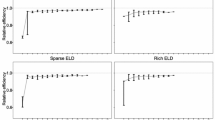Abstract
We consider some computational issues that arise when searching for optimal designs for pharmacokinetic (PK) studies. Special factors that distinguish these are (i) repeated observations are taken from each subject and the observations are usually described by a nonlinear mixed model (NLMM), (ii) design criteria depend on the model fitting procedure, (iii) in addition to providing efficient parameter estimates, the design must also permit model checking, (iv) in practice there are several design constraints, (v) the design criteria are computationally expensive to evaluate and often numerical integration is needed and finally (vi) local optimisation procedures may fail to converge or get trapped at local optima.
We review current optimal design algorithms and explore the possibility of using global optimisation procedures. We use these latter procedures to find some optimal designs.
For multi-purpose designs we suggest two surrogate design criteria for model checking and illustrate their use.
Similar content being viewed by others
References
A1-Banna, M. K., Kelman, A. W. and Whiting, B. (1990) Ex-perimental design and effcient parameter estimation in population pharmacokinetics. Journal of Pharmacokinetics and Biopharmaceutics, 18, 347–60.
Atkinson, A. C. and Cox, D. R. (1974) Planning experiments for discriminating between models (with discussion). Journal of the Royal Statistical Society, Series B, 36, 321–48.
Atkinson, A. C. and Donev, A. N. (1992) Optimum Experimental Design. Oxford University Press, Oxford.
Atwood, C. (1976) Convergent design sequences for suffiently regular optimal criteria. Annals of Statistics, 6, 1124–38.
Breslow, N. E. and Clayton, D. G. (1993) Approximate inference in generalized linear models. Journal of the American Sta-tistical Association, 88, 9–25.
Chaloner, K. and Verdinelli, I. (1995) Bayesian experimental de-sign – a review. Statistical Science, 10, 273–304.
Clyde, M. and Chaloner, K. (1996) The equivalence of con-strained and weighted designs in multiple objective design problems. Journal of the American Statistical Association, 91 1236–44.
Davidian, M. and Giltinan, D. M. (1995) Nonlinear Models for Repeated Measurements Data. Chapman and Hall, New York.
Deleon, A. C. P. and Atkinson, A. C. (1991) Optimum experi-mental design for discriminating between two rival models in the presence of prior information. Biometrika, 78, 601–8.
Dixon, L. C. W. and Szego, G. P. (1978) The global optimization: an introduction. In Towards Global Optimisation, 2, Dixon and Szego, Ed, North-Holland, Amsterdam.
Fedorov V. V. (1972) Theory of Optimal Experiments. New York: Academic Press.
Fletcher, R. (1987) Practical Methods of Optimization. 2nd Ed., Wiley, Chichester.
Kirpatric, S., Gelatt, C. D. and Vecchi, M. P. (1993) Optimization by simulated annealing. Science, 220, 671–80.
Goffe, W. L., Ferrier, G. D. and Rogers, J. (1994) Global opti-mization of statistical functions with simulated annealing. J. Econometrics, 60, 65–99.
Lee, Y. and Nelder, J. A. (1996) Hierarchical generalized linear models Journal of the Royal Statistical Society B 58, 656–78.
Lindstrom, M. J. and Bates, D.M. (1991) Nonlinear mixed effect models for repeated measures data. Biometrics, 46 673–87.
Mentré, F., Mallet, A. and Baccar, D. (1997) Optimal design in random effect regression models. Biometrika, 84, 429–42.
O'Brien, T. E. and Rawlings, J. O. (1996) A nonsequential design procedure for parameter estimation and model discrimina-tion in nonlinear regression models. J. Statist. Plann. Infer-ence, 55, 77–93.
Protter, M. H. and Morrey, C. B. (1964) Modern Mathematical Analysis. Addison-Wesley. Reading, Massachusetts.
Rinnooy Kan, A. and Timmer, G. (1987) Stochastic global op-timisation methods – Part I. Math Program, 39, 27–56.
Sheiner, L. B. and Beal, S. L. (1980) Evaluation of methods for estimating population pharmacokinetic parameters I. Mi-chaelis-Menten model: Routine clinical pharmacokinetic data. Journal of Pharmacokinetics and Biopharmaceutics, 8, 553–71.
Sheiner, L. B. and Beal, S. L. (1983) Evaluation of methods for estimating population pharmacokinetic parameters III. Monoexponential model: Routine clinical pharmacokinetic data. Journal of Pharmacokinetics and Biopharmaceutics, 11, 303–19.
Wu, J. F. (1987) Some algorithmic aspects of theory of optimal design. Annals of Statistics, 6, 1286–301.
Wynn, H. P. (1970) The sequential generation of D-optimum experimental designs. Ann. Math. Statist., 41, 1655–64.
Yue, R. and Hickernell, F. J. (1995) Robust optimal designs for fitting approximate linear models. Technical Report. Dept. Mathematics, Hong Kong Baptist University.
Rights and permissions
About this article
Cite this article
Jones, B., Wang, J. Constructing optimal designs for fitting pharmacokinetic models. Statistics and Computing 9, 209–218 (1999). https://doi.org/10.1023/A:1008922030873
Issue Date:
DOI: https://doi.org/10.1023/A:1008922030873




